SUSTAINABLE TOURISM DEVELOPMENT Table of contents Introduction
23 Pages7134 Words346 Views
Added on 2019-12-28
About This Document
SUSTAINABLE TOURISM DEVELOPMENT Table of contents Introduction 3 Task 1(LO1, AC1.1, AC1.2) 3 P1.1 Discussing benefits received from stakeholders through planning of development of tourism 3 P1.2 Discussing advantages and disadvantages of private/public sector planning partnerships of tourism 4 Task 2 (LO2, AC2.1, 2.2, 2.3) 5 P2.1 Analysing features of planning procedures and systems for developing tourism 5 P2.2 Evaluating importance of communicative planning procedures and systems in the development
SUSTAINABLE TOURISM DEVELOPMENT Table of contents Introduction
Added on 2019-12-28
ShareRelated Documents
SUSTAINABLE TOURISM DEVELOPMENT

Table of contentsIntroduction......................................................................................................................................3Task 1(LO1, AC1.1, AC1.2)...........................................................................................................3P1.1 Discussing benefits received from stakeholders through planning of development of tourism.........................................................................................................................................................3P1.2 Discussing advantages and disadvantages of private/public sector planning partnerships oftourism.............................................................................................................................................4Task 2 (LO2, AC2.1, 2.2, 2.3).........................................................................................................5P2.1 Analysing features of planning procedures and systems for developing tourism...................5P2.2 Evaluating importance of communicative planning procedures and systems in thedevelopment of tourism...................................................................................................................6P2.3 Evaluating several methods that are available for measuring impacts of tourism..................6P3.1 justifying concept of sustainable tourism development referring to Philippines case study...7P3.2 Analysing factors which might hinder sustainable development of tourism..........................1P3.3 Analysing several stages of planning with respect to sustainability.......................................1Task 4...............................................................................................................................................3P4.1 Evaluating methods to resolve conflicts for ensuring future betterment of any developingdestination of tourism......................................................................................................................3P4.2 Analysing implications of demand and supply being balanced..............................................3P4.3 Evaluating ethical and moral issues of enclave tourism..........................................................4Task 5...............................................................................................................................................4P5.1 Comparing recent issues of tourism development in any developing countries and anupraising destination........................................................................................................................4P5.2 Evaluating future development of tourism with recommendation..........................................5Conclusion.......................................................................................................................................8References......................................................................................................................................12
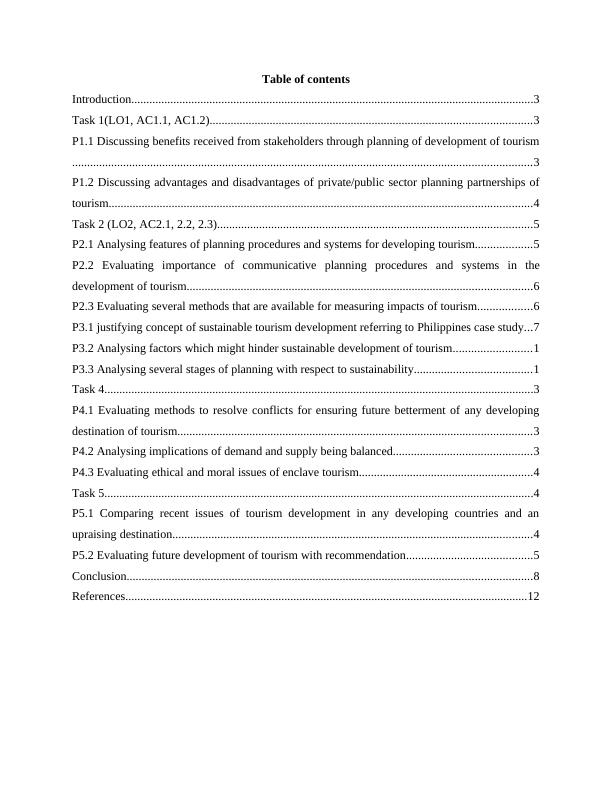
IntroductionProper understanding of the rationally for the tourism organisational planning seems to be theprime objective of the development in the industry of tourism in a sustainable manner. Thesupport of the organisation of the tourism and industry is remarkable in the present era as itsupport the economy of the country hosting in a great deal. The work here discusses regardingthe collaboration, advantage and disadvantages along with the sustainable development in theTourism Organisation. The different level about planning in a sustainable development oforganisation does impact the customers and in this work the preferences are also discussed. Task 1(LO1, AC1.1, AC1.2)P1.1 Discussing benefits received from stakeholders through planning of development oftourismStakeholders of an organisation can be defined as the person or a group of people who derivebenefit by providing some expense to the organisation. Stakeholders of travel and tourismorganisation or a business can be the tourist the government and the private businesses alongwith the local residents who try aiming towards the revenue through promotion of tourismindustry. The stakeholders such as the government and other governmental bodies get thebenefits of tax and other private organisation enjoy the profit from the employment under thetourism industryAs supported Poudel et al. (2016, p.476), long and short term benefit can be derived fromtourism through economic development of destination host country. Proper Maintaining of thetourist spot and destination in the country needs to be the prime objective of the organisationrelated to travel and tourism. Advantages and disadvantages are the two things that cannot beseparated from any of the implementation that brings in profit of development in an organisationor a country. Both positive and negative impact can be derived from the implementation of thedecisions for the betterment of the tourist spot in a country. However, as contradicted by Goharand Kondolf (2016, p.40), management do not and does not contribute only to the developmentof the tourist destination but also provide betterment of the sustainable development inmaintaining benefits to the customers of the society.Achievement and implementation of well supported process for business environmental industryhealth indicator development and improving of the situation of stakeholders in rising ofreputation, faith and trustworthiness. Evidently in terms of Philippines case scenario most
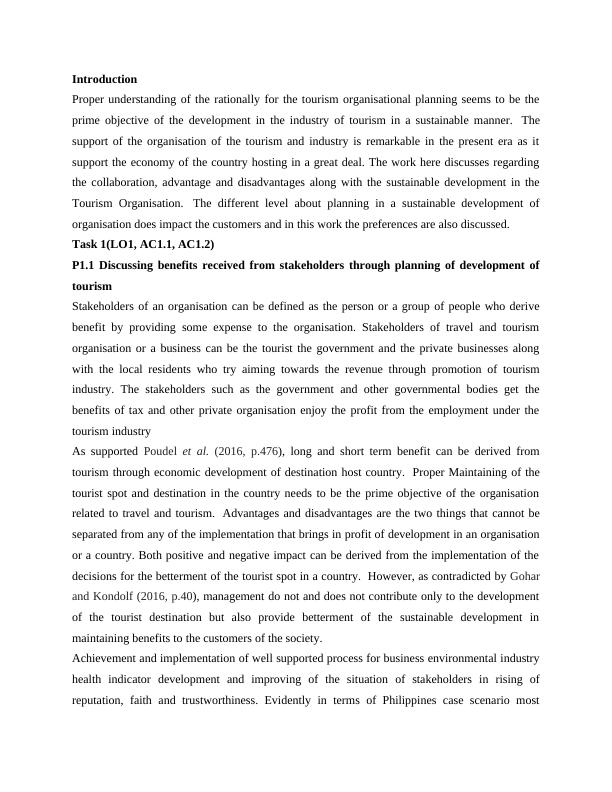
importantly the development process of any of the Tourism Organisation trying to bring anessence into the development of the stakeholders or the leading of life of the stakeholders. Inwords of Gabdrakhmanov et al. (2016, p.21), the planning process also so important in the betterunderstanding among the stakeholders which further leads to coordination with the TourismOrganisation in society for further development. The tick holders of the organisation also getadvantages of bitter employment chances, protection of wildlife, betterment of landscape,maximization of profit, proper infrastructure, consumer protection and betel involvement ofstakeholder as a part of the family. The stakeholders are also benefited with the development inthe natural resources with sustainable development of tourism industry. As mentioned byWeaver and Jin (2016, p.670), it is often seen that the cultural importance of a State Power tothe spot does increased with better development in the tourism industry on that place. Asinformed by Shone et al. (2016, p.1680), the development in human resource is the primeconcern that is at a high place in developing with the development of The Tourist Industry. P1.2 Discussing advantages and disadvantages of private/public sector planningpartnerships of tourismAs supported by Önder et al. (2017, p.250), advantages and disadvantages of any of the sectorwith the collaboration to a single organisation have been together for ages. Advantages anddisadvantages of implementing new ideas, collaboration development proper utilisation ofresources are inseparable. it is evident that public and private sector tourism health to bring himbetter development in a simple and sustainable manner for the better development of theorganisation. Opportunities and chances for the development of an organisation is highly relatedto the development of the sector they are collaborating with. As mentioned by Zaman et al.(2016, p.280), sustainable development of tourism organisations in society brings in advantagesand disadvantages that is inevitable in nature in the society which further help in definingdevelopment and dynamic nature of society along with the organisation. most importantly assupported by Vieira et al. (2016, p.130), disadvantages of the public and private sector in theprocess of planning do collide with each other as Department of Public and private Organisationin the tourism tries reduction of the cost for the operation in the capital structure of theorganization. Tourism industry has helped in the development of the living standard of thecustomers in the society. They have also help in the increasing of the cultural heritage andidentification of improvement in natural environment. as mentioned by Zhu et al. (2017, p.160),
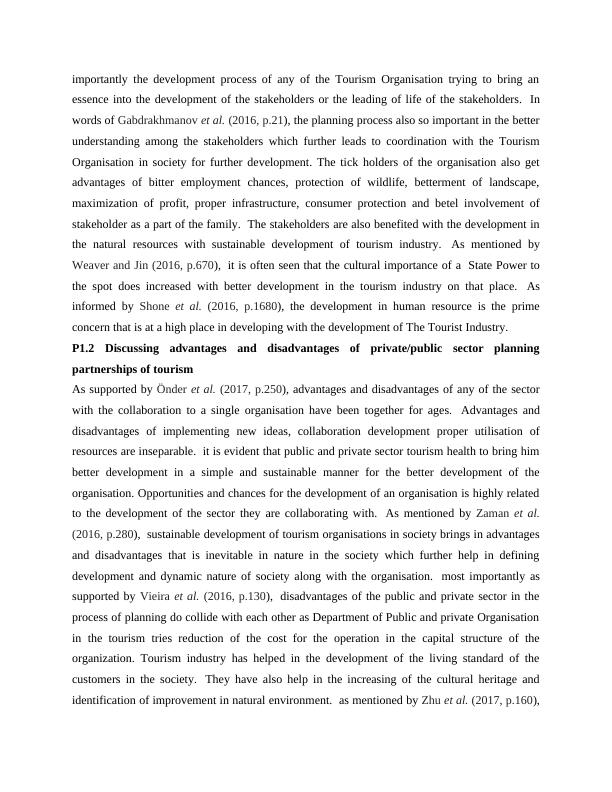
the support of the sustainable development in tourism industry have great positive impact overthe development in the tourism industry and to the spot. In accordance to the Philippines casescenario, better form of partnership with private organisations may help Tourism industry striveforward with the profitability in the organization and the betterment of the customers and thestakeholders. As supported by Edgell (2016, p.76), the sharing of the risk and the development isoften with the better collaboration with the public and the private organisation along with thetravel and tourism industry have become evident. As mentioned by Boley et al. (2017, p.75),Will lack of initiative and innovation MP tourism sector Industries have brought in imbalance inthe process of selection which means that, at the selection process there would not be any propermaintenance of skill and there will be degradation in the partnership between public and privatesectors which was meant for the development of the tourism industry in situation of thePhilippines case scenario.Task 2 (LO2, AC2.1, 2.2, 2.3)P2.1 Analysing features of planning procedures and systems for developing tourismTourism planning is crucial for upgrading the facilities available to the consumers for a bettertravel and tourism procedure. As per the observations of Holmes et al. (2016, p.1190), a tourismplan gets successful through implementation of better ideas, thoughts and views that are beinggenerated through the planning procedures of tourism. Any planning procedure of tourismincludes the approval to be passed through different levels-international, national, local andregional levels. In words of Xu et al. (2016, p.280), the plans suggested under the planningprocedure of tourism and travel at these four levels vary in environmental, economical and socialaspects. Planning is regarded as the prime concept for improving the facilities that are beingprovided through tourism industry. The Philippines travel organisation, through a perfectplanning procedure, clients’ satisfaction levels get absolute worth since the services to beprovided would be economical, environmental friendly and socially acceptable.Planning is therefore, termed as one of the preliminary steps which is utmost required to becarried out with sheer efficiency. The four basic levels of planning tourism might be different yetthe features remain similar. Hierarchical structure that is being maintained for absorbingdifferent ideas, views, opinions and ideas is to set the level of tourism at its epitome of receivingsuccess. Growth in the tourism industry is being adjusted or regulated through the performanceof these four levels and the features of the plan they bother to implement the sustainable growth
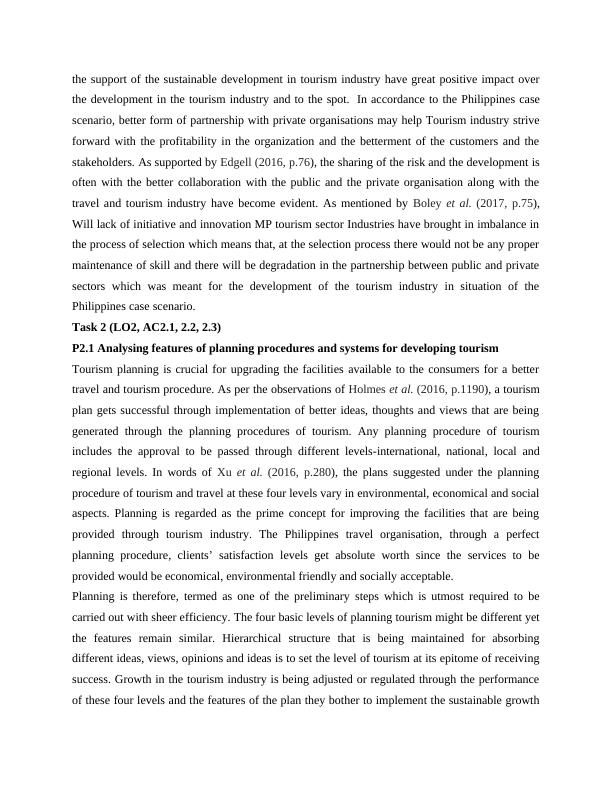
in context of Philippines travel organization and case scenario. In the views of Anctil and Blanc(2016, p.790), local and regional tourism planning involves preliminary suggestions and steps toform the base of the tourism industry and plans about tourism guidance in a particular locality,whereas, international and national tourism levels bother to implement broader and wide ideasthat might generate profit and fame to the industry of tourism. P2.2 Evaluating importance of communicative planning procedures and systems in thedevelopment of tourismInteractive procedure of planning is being regarded as the effective process for understanding thecurrent organisational state, capabilities as well as changes which are required as mandates underthe sector of tourism and travel. According to the observations of Andersen et al. (2016, p.7), theinteractive procedure is generally, a step to analyse varied situations regarding the growth orimprovement in the tourism industry of any nation. The several systems of the planningprocedures engaged in the sector of tourism involves strategic and short term procedures thatmight be implemented through four of the levels of planning under tourism industry. Evolutionand successive growth in the tourism sector are being the major determinants of the improvedtourism sector in any economy. The system of planning being conventional is also referred to beoriented yet at times it tends to be unclear and congested in terms of Philippines case scenario.The involvement of interactive planning procedure in the tourism and travel sector would assistin proper development and collaboration of the aspects of tourism for satisfying the customersand clients through the services that are being delivered.A successful tourism requires the utmost attention of the customers and their repetitive use of theservices delivered by that particular organisation of tourism and travel. Sustainable tourism thatincludes interactive methods of planning develops a different perception and image abouttourism within the nation that is being guided through the four levels of planning with respect thescenario of Philippines as per the case study. The prime objective of interactive procedure ofplanning is to help out the people who can hardly afford to make international training at aluxurious way. In order to cover up all the localities, regions and communities of the society, thisinteractive procedure of planning is being suggestively incorporated. P2.3 Evaluating several methods that are available for measuring impacts of tourismAmple methods for measuring the impacts or effect of tourism include quantitative andqualitative methods in order to measure the effectiveness of the planning procedures of tourism.
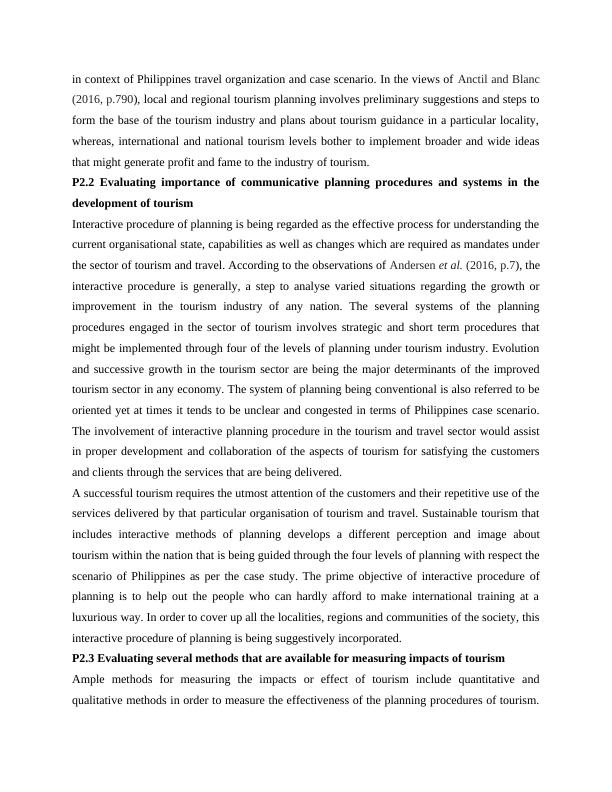
End of preview
Want to access all the pages? Upload your documents or become a member.
Related Documents
Report on Planning in Philippines Tourism Industrylg...
|13
|4124
|77
NINA SUSTAINABLE TOURISM DEVELOPMENTlg...
|28
|6550
|180
Tourism Development: Impact of Public-Private Sector Partnership on Tourism Developmentlg...
|13
|4093
|160
[PDF] Sustainable Tourism Developmentlg...
|17
|5338
|735
Stakeholders and Benefits in Tourism Developmentlg...
|12
|631
|50
Sustainable Tourism Development Conceptlg...
|14
|4281
|321
